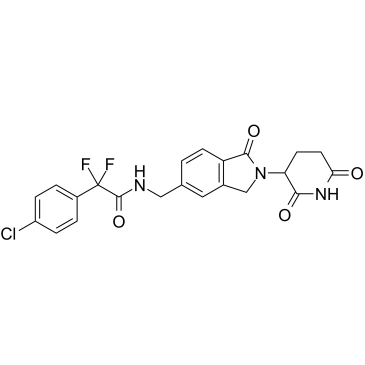1860875-51-9
| Name | Cereblon modulator 1 |
|---|
| Description | Cereblon modulator 1 (compound F) is a cereblon (CRBN) E3 ligase modulator. Cereblon modulator 1 specifically binds to CRBN, thereby affecting the activity of the ubiquitin E3 ligase complex. This leads to the ubiquitination of certain substrate proteins and induces the proteasome-mediated degradation of certain transcription factors, including Ikaros (IKZF1) and Aiolos (IKZF3)[1][2]. |
|---|---|
| Related Catalog | |
| Target |
Cereblon |
| In Vitro | A different CRBN-binding compound, Cereblon modulator 1 (compound F), that demonstrates anti-proliferative activity in non-AML hematological cancer cell lines (such as multiple myeloma) does not inhibit cell growth in any of the 11 AML cell lines tested, including the ten cell lines that are sensitive to the growth inhibitory activity of Compound D. However, when excess Cereblon modulator 1 is added to KG-1 AML cell cultures in the presence of Compound D, the anti-proliferative activity of Compound D is reduced, presumably due to competition for binding of Compound D to CRBN. The relative impact of Cereblon modulator 1 on the anti-proliferative effect of Compound D progressively increased with increasing concentrations of Cereblon modulator 1. In the presence of 100 µΜ Cereblon modulator 1, the potency of Compound D in inhibiting cell growth reduced by approximately 60-fold, and the potency of Compound D in inducing apoptosis reduced by approximately 40-fold[1]. |
| References |
[2]. CC-90009 |
| Molecular Formula | C22H18ClF2N3O4 |
|---|---|
| Molecular Weight | 461.85 |
| Storage condition | -20°C |
